India Meteorological Department – What You Need to Know
When you hear about India Meteorological Department, the national agency that monitors weather, issues forecasts and studies climate patterns across the country. Also known as IMD, it operates under the Ministry of Earth Sciences and provides critical data for agriculture, aviation, and public safety.
One of its flagship services is Monsoon Forecasting, the process of predicting the onset, intensity and withdrawal of the seasonal monsoon using satellite imagery, ocean temperature readings and historical trends. This capability requires accurate satellite data and a dense network of ground stations. Another key tool is Weather Radar, a high‑resolution radar system that scans the atmosphere in real time to detect rain, thunderstorms and severe weather events. Together, monsoon forecasting and weather radar enable faster, more reliable warnings for floods and cyclones. Climate Research, long‑term studies of temperature trends, greenhouse gas levels and extreme weather patterns feeds into both services, ensuring they stay relevant as the climate changes.
IMD’s data collection hinges on three pillars: satellite observations, a nationwide network of automatic weather stations, and the weather radar grid. Satellite inputs give a big‑picture view of cloud cover and sea‑surface temperatures, while ground stations capture local temperature, humidity and wind speed. The radar grid fills the gap by delivering minute‑by‑minute updates on precipitation intensity. This layered approach creates a comprehensive picture of the atmosphere, which is then turned into actionable forecasts and warnings.
Beyond raw data, the department’s public services include daily weather bulletins, severe storm alerts, and a seasonal outlook portal that farmers check before planting. Aviation pilots rely on IMD’s aeronautical forecasts for flight planning, and health officials use heat‑wave warnings to prepare hospitals. The link between these services and Disaster Management, the coordinated effort to mitigate loss from natural hazards is direct: timely forecasts reduce loss of life and property by allowing authorities to evacuate vulnerable areas ahead of a storm.
India’s varied geography—from the Himalayas to the coastal plains—poses unique challenges for the department. Rapid urbanization, changing land use and a warming climate all push the limits of prediction models. To stay ahead, IMD invests in newer high‑resolution models, expands its radar coverage, and collaborates with international bodies for data sharing. These efforts enhance forecast accuracy and help the country adapt to a more volatile weather future.
Below you’ll find a curated collection of articles that dig deeper into each of these areas. Whether you’re looking for the latest monsoon outlook, details on how weather radar works, or insights into climate research trends, the posts provide practical explanations and real‑world examples. Explore the list to see how the India Meteorological Department’s work impacts everyday life across the nation.

28
Oct
Cyclone Montha made landfall near Kakinada, Andhra Pradesh, on October 28, 2025, with 110 kmph winds and a one-metre storm surge. Over 120,000 evacuated as IMD issued red alerts across 23 districts. Heavy rain spread to Odisha, Maharashtra, and the Northeast.
Read More

6
Oct
IMD warns of heavy rainfall across eastern and central India, with Delhi hit by wet spell on Oct 5‑6 as a western disturbance and Cyclone Shakti stir gusty winds and cooler temps.
Read More

